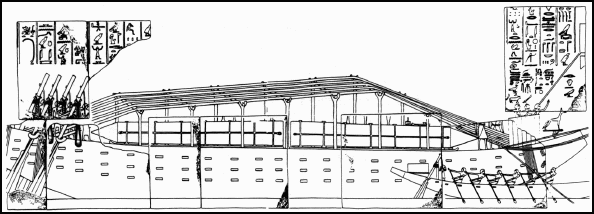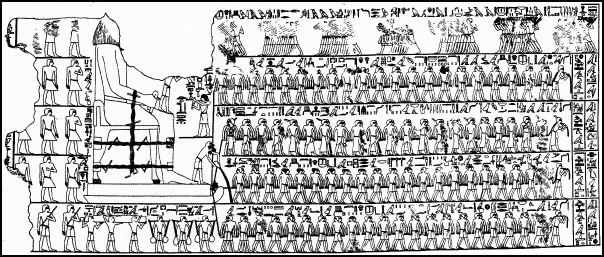Skip to comments.
MICHIGAN MAN MAY HAVE TAPPED SECRETS OF THE ANCIENTS
The Flint Journal (w o r l d w i d e a n o m a l o u s p h e n o m e n a r e s o u r c e) ^
| 3-20-2004
| Kim Crawford
Posted on 03/24/2004 4:56:10 PM PST by vannrox
But then, the blocks that Wallace T. Wallington moves around near his home in a rural Flint area have weighed up to nearly 10 tons. And by himself, he moves these behemoth playthings, not with cranes and cables, but with wooden levers.
"It's more technique than it is technology," Wallington says. "I think the ancient Egyptians and Britons knew this."
Last October, a production crew from Discovery Channel in Canada came to Wallington's home to record him as he raised a 16-foot, rectangular, concrete block that weighed 19,200 pounds and set it into a hole. That taping was made into a segment, which has aired on Discovery Canada and the Discovery Science program in the United States.
That project resulted in a column, standing more than 10 feet high in his yard. He says he intends to construct his own kind of Stonehenge -- without cranes or any modern engines or machines. He believes that's the way ancient people moved and constructed the great landmarks of the world.
"I call it the forgotten technology," he says.
He's posted clips and photos and information about his experiments on his Web site, theforgottentechnology.com.
Wallington's experiments and projects have attracted the attention of some physicists who discuss theories as to how the ancients moved and stacked giant, 30-foot blocks of stone at a time when there was no steel for cables or supports, let alone hydraulic devices for raising heavy materials.
The more far-out theories, espoused by believers of the paranormal, say that humans couldn't have done these incredible feats of engineering, so that it must have been beings from other planets.
Others think there must have been advanced civilization here on Earth that could build or erect incredible monuments such as the Easter Island statues or Machu Picchu, the great Peruvian mountainside architectural wonder.
Nonsense, says Wallington. "If we had these great advanced civilizations, why didn't we find any of their cellphones or laptops?" he asks with a smile.
Besides, if he can move and stand a nearly 10-ton block on his own, using only tools of wood and stones for fulcrums, then certainly the ancients, with thousands of laborers, could build the pyramids.
"I know how they did it," he says with absolute certainty. "I'd always thought there was a simple explanation, but it's really beyond simple."
Now he just has to convince the rest of the world.
"There's one guy who's published his experiments who says, Three men can pull a block weighing a ton,' " Wallington says. "But I can pull over a ton alone. I've moved 19,200 pounds, and I'm nowhere near the limit."
Wallington is a short, pipe-smoking, fireplug of a man, a carpenter by trade and a construction superintendent when he retired several years ago. He prefers not to say where he lives in the Flint area -- the TV producers, he says, advised him that he didn't want a bunch of people coming to his house once the bars close to see if they, too, could move concrete slabs weighing several tons.
Born in Detroit and raised in Utica, Wallington worked in construction for 35 years. He says he first thought about the ancient builders about 15 years ago, when he was working on a construction job.
"We were moving an existing floor," says Wallington. "I had to remove these 1,200-pound blocks of concrete. We couldn't get to all of 'em with our machine. I didn't really want to break them up, so I'd raise 'em with a lever and then tip them up and move them. I got to be pretty good at it."
That was the beginning of Wallington's thoughts on the engineering of the past. He started small, experimenting with blocks of concrete that weighed hundreds of pounds. But when he retired several years later, he really threw himself into his projects.
"At first, I brought a 1-ton block home from work," he says. "But I found I could move it around by myself pretty easily."
Then he started moving even heavier concrete blocks and columns, and then built a wooden device of two-by-fours he called "the Wallington lever" that he could saddle around the blocks.
Depending on the firmness of the ground, or by using a couple of rocks for fulcrums or swivels slipped beneath his blocks on hard surfaces, he could "walk" heavy blocks by pushing the arms of his lever.
Not surprisingly, his wife and his children thought he was crazy. "What's Dad up to now?" was, he says, a typical comment.
But Wallington also learned to raise a heavy column off the ground using a "shoring box" that allowed him to tilt it slightly and slip boards underneath it, one at a time. That let him elevate heavy blocks that would otherwise be impossible for one man to lift.
Having learned these techniques, he built a practice "mini-Stonehenge" of blocks weighing more than a ton, that he set up and raised without a pulley, hoist, roller or crane.
In an attempt to set a world record, he moved a 10,400-pound concrete column by himself, without any rollers. He even moved a large out-building for one of his sons.
"Yeah, it was a 30-by-40-foot pole barn," he says. "By myself, I could move it at about 6 feet per hour. With my son, we doubled that speed. We ended up moving it more than 200 feet."
In the meantime, his grown children did some research for him, gathering information about the pyramids of Egypt and other building marvels of antiquity. Wallington says that as he studied these, he became convinced he understands how these wonders of the world were built.
A couple of years ago, he posted a record of his experiments and experiences on the Web site created by his son.
"...There has to be a more accurate explanation," he writes about the construction of the pyramids. "I believe skilled individuals performed the work. I have found that this work could easily be done using only primitive tools and physics."
Between his Web site, the Discovery Channel segment and a video recording of his 2003 experiment (on DVD or VHS formats) that he sells for $20 via his "forgotten technology" Internet site, Wallington has gathered comments and kudos from various experts, authors and buffs interested in the ancient engineering.
One called Wallington "an original thinker." Another asked "has he figured it out?" referring to the engineering secrets of the past.
Joseph Turbeville, a retired professor of physics from the University of Southern Florida, called Wallington's videotaped project "an impressive undertaking."
"Every teacher of physics should make an effort to acquire a copy of this tape ..." wrote Turbeville.
What's next for Wallington? His project this year is for what he calls an "Egyptian hoist," based on experiments where he found he could pull as much as 185 pounds up a ramp about 26 degrees with very little effort.
He's stayed in touch with the TV producers who made the segment last fall about his raising of the nearly 10-ton column, and he expects they'll be back again to film his 2004 project. He says his family, friends and neighbors no longer are surprised at his experiments.
"Oh, I have a lot of nicknames," he says with a smile. "The Pharaoh. The Professor. Mr. Lever. The Man Who was Born 4,000 Years Too Late."
TOPICS: Business/Economy; Culture/Society; Extended News; Foreign Affairs; Israel; Miscellaneous; News/Current Events; Philosophy; US: Florida; US: Massachusetts; US: Michigan; United Kingdom
KEYWORDS: ability; ancient; archaeoastronomy; archaeology; block; design; egypt; engineering; ggg; godsgravesglyphs; history; machupicchu; manner; megaliths; michigan; move; past; pryamid; science; secret; stonehenge; study; technique
Navigation: use the links below to view more comments.
first previous 1-20, 21-40, 41-60, 61-70 next last
To: putupjob
Herodotus wrote that it would took 30 years and 100,000 slaves to have built the great Pyramid of Cheops. There are 2,300,000 blocks of stone with an average weight of 2.5 tons each in the structure. Assuming that they worked five months per year when the Nile was flooded (although that may have been only to move the blocks), that would be 76,666 per year, or 15,333 per month. Using a thirty day month that's 511 per day. Working twelve hours per day, that is about 43 per hour. If you divide 100,000 into 200 man teams, there would be 500 teams, so each team would have move about one block per day.
Whatever the actual numbers, it's no mystery.
To: CathyRyan
My first job was cutting telephone cable off those large metal reels. This was back when the wire was copper with a paper insulation and all the wires were sheathed in 1/8th thick lead.
I seem to remember that we had an average of 12,000 pounds to a reel. I learned how to move the reels around by myself with just a crowbar or 2 by 4.
42
posted on
03/24/2004 6:39:02 PM PST
by
Shooter 2.5
(Don't punch holes in the lifeboat)
To: Anubus
I'm curious if this dude also has the secrets to the "trilithons" in baalbek (yeah right). Those suckers weigh over a 1000 tons each and were quarried miles away. Just because they were ancient, doesn't mean they weren't clever. Here's one of the many tricks they used:
Herodotus described moving the 580 ton "Green Naos" under Nectanebo II: "This took three years in the bringing, and two thousand men were assigned to the conveying of it ..." (History, 2.175) Pliny wrote of the transportation of an "eighty cubit" obelisk under Ptolemy II: According to some authorities, it was carried downstream by the engineer Satyrus on a raft; but according to Callixenus, it was conveyed by Phoenix, who by digging a canal brought the waters of the Nile right up to the place where the obelisk lay. Two very broad ships were loaded with cubes of the same granite as that of the obelisk, each cube measuring one foot, until calculations showed that the total weight of the blocks was double that of the obelisk, since their total cubic capacity was twice as great. In this way, the ships were able to come beneath the obelisk, which was suspended by its ends from both banks of the canal. The blocks were unloaded and the ships, riding high, took the weight of the obelisk. (Natural History, 36.14)

To: putupjob
And some of these are 70 tons. Hmm... I'm not sure if the Michigan story is the whole story. Well, the technique can be scaled up by just increasing the number of workers:

This is a relief from the tomb of Djehutihotep. Note that a) there are a crapload of workers depicted, and b) there's a guy at the front of the statue pouring some sort of liquid in front of it, perhaps water or oil, to allow the statue to slide more easily.
To: vannrox
It is amazing and one of those simple solutions no "modern" man would consider.
The round road was awesome and the use of roller counterweights would speed things up considerable.
I had to move a 26,000 lb power hammer 0ff it's foundation once, raised it a foot using a hammer and wedges with cribbing for safety, eventually got tired and was under some time constraints so rented a
BIG fork lift, knocked a wall out and moved it, but once I got it an inch high I knew I could
do it if I had to, you see it was moving for me.
This guy is cool.
A bit like Aikido, physics in everyday life.
45
posted on
03/24/2004 6:50:34 PM PST
by
tet68
( " We would not die in that man's company, that fears his fellowship to die with us...." Henry V.)
To: i_dont_chat
thanks was looking for that
46
posted on
03/24/2004 6:52:46 PM PST
by
joesnuffy
(Moderate Islam Is For Dilettantes)
To: AFreeBird
To: vannrox
btt
48
posted on
03/24/2004 6:55:14 PM PST
by
Ciexyz
To: vannrox
The guy who built Coral Castle in Florida did the same thing. It's a really weird story if you like that sort of thing. Just do a search on "coral Castle". There's a guy I heard on the radio that wrote a book about it, I think the website is www.waitingforagnes.com.
49
posted on
03/24/2004 6:58:22 PM PST
by
dljordan
To: Willie Green
"Give me a lever long enough, and I shall move the world." ~Archimedes
Actually, he said something to the effect:
"give me a lever long enough and a place to stand and I can move the Earth."
Although he never, as far as we know, ever said anything like Newton's laws of conservation of force or momentum, it appears that Archimedes had some intuitive understanding of them. In any case, you can't have a lever without a fulcrum.
To: Virginia-American
Actually, he said something to the effectYeah, I came across several variations of the quote when I did a quick search on the Web.
I imagine much of the Secrets of the Ancients must've been lost through translation.
One of the quotes even had Archimedes looking for a place to stand, but left out the reference to the lever.
Sheeesh! Go figger!
;^)
To: vannrox
Go to bed. Please.
To: i_dont_chat
I live 5 miles from Coral Castle and it's a pretty interesting place to visit. When you look at it, then see the pictures of the scrawny man who did the building it is amazing.
53
posted on
03/24/2004 9:40:24 PM PST
by
Brytani
(Politics: n. from Greek; "poli"-many; "tics"-ugly, bloodsucking parasites.)
To: TexasTransplant
Sounds like you've been using one of those. Did you get your transplant in Texas or are you just bragging?
54
posted on
03/24/2004 9:43:01 PM PST
by
Bernard Marx
(In theory there's no difference between theory and practice. But in practice there is.)
To: Shooter 2.5
I seem to remember that we had an average of 12,000 pounds to a reel. I learned how to move the reels around by myself with just a crowbar or 2 by 4. Me too. I used to have to haul huge reels of cable, 600 lb. up to the size you mention, in my little bobtail truck. I became very skilled at moving them with simple leverage. I even learned to get them off the truck without forklifts and lift gates. It's amazing what you can do when you simply have to get things done!
55
posted on
03/24/2004 9:51:41 PM PST
by
Bernard Marx
(In theory there's no difference between theory and practice. But in practice there is.)
To: dc-zoo
The difference is old Ed also held the secret of cutting the huge blocks as well as moving them. Yep, therein lies the true mystery. I can see how the oldies cut stone, and rotated them and dropped them into holes. However... How the heck did these old doofies move these blocks and get them up in an ascending fashion as with a pyramid? That has always been the true puzzler, which even this guy doesn't answer.
56
posted on
03/24/2004 10:27:21 PM PST
by
Thommas
To: farmfriend
BTTT!!!!!
57
posted on
03/25/2004 3:09:35 AM PST
by
E.G.C.
To: Bernard Marx
Once in awhile, the cable factory would overload one of the reels. We had an especially made fork truck that would haul the reels from the dock to our section. The reels were so heavy that we would guide the truck and take a step and wait for the truck, then take another step and then wait for the truck again. We still had to unload the reel from the truck and then hand manipulate the reel to a parking spot.
My partner was a light weight Golden Gloves contender who was in the Battle of the Bulge.
It was a rough job but the friends made it a lot of fun.
58
posted on
03/25/2004 6:02:31 AM PST
by
Shooter 2.5
(Don't punch holes in the lifeboat)
To: Anubus
No kidding, I did these same calculations a few years ago. Egyptology is a hobby. Don't forget, the whole outside of the pyramid was covered/cased in polished limestone after the blocks were laid, so thats even MORE time needed. personally, I think the pyramids are much older anyway, and sumerian writings seem to confirm that. The last I heard about attempts to date the pyramids was when that little robot shaft-climber brought back TV images of a piece of wood - which can be carbon-dated, unlike stone. But the Egyptian government refused permission to retrieve it, since the last thing they wanted to do was risk the possible discovery that the pyramids are far older than Egyptian civilization. Science doesn't mix well with politics.
To: isthisnickcool
Don't forget Ted. He's a "black hole".
Navigation: use the links below to view more comments.
first previous 1-20, 21-40, 41-60, 61-70 next last
Disclaimer:
Opinions posted on Free Republic are those of the individual
posters and do not necessarily represent the opinion of Free Republic or its
management. All materials posted herein are protected by copyright law and the
exemption for fair use of copyrighted works.
FreeRepublic.com is powered by software copyright 2000-2008 John Robinson


